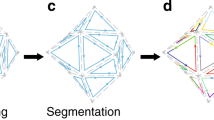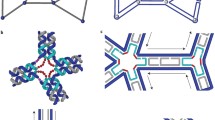Abstract
Living systems achieve robust self-assembly across a wide range of length scales. In the synthetic realm, nanofabrication strategies such as DNA origami have enabled robust self-assembly of submicron-scale shapes from a multitude of single-stranded components. To achieve greater complexity, subsequent hierarchical joining of origami can be pursued. However, erroneous and missing linkages restrict the number of unique origami that can be practically combined into a single design. Here we extend crisscross polymerization, a strategy previously demonstrated with single-stranded components, to DNA-origami ‘slats’ for fabrication of custom multi-micron shapes with user-defined nanoscale surface patterning. Using a library of ~2,000 strands that are combinatorially arranged to create unique DNA-origami slats, we realize finite structures composed of >1,000 uniquely addressable slats, with a mass exceeding 5 GDa, lateral dimensions of roughly 2 µm and a multitude of periodic structures. Robust production of target crisscross structures is enabled through strict control over initiation, rapid growth and minimal premature termination, and highly orthogonal binding specificities. Thus crisscross growth provides a route for prototyping and scalable production of structures integrating thousands of unique components (that is, origami slats) that each is sophisticated and molecularly precise.





Similar content being viewed by others
Data availability
All raw TEM image data that were measured to determine growth and nucleation of origami crisscross megastructures are available upon request from W.M.S.
Code availability
Scripts that were used to make various assignments of handles of staple oligonucleotides, and scripts that were used to measure Hamming distances of sequence assignments, are available at https://github.com/aersh/origamicrisscross.
Change history
23 March 2023
A Correction to this paper has been published: https://doi.org/10.1038/s41565-023-01365-8
References
Rothemund, P. W. K. Folding DNA to create nanoscale shapes and patterns. Nature 440, 297–302 (2006).
Douglas, S. M. et al. Self-assembly of DNA into nanoscale three-dimensional shapes. Nature 459, 414–418 (2009).
Andersen, E. S. et al. Self-assembly of a nanoscale DNA box with a controllable lid. Nature 459, 73–76 (2009).
Benson, E. et al. DNA rendering of polyhedral meshes at the nanoscale. Nature 523, 441–444 (2015).
Han, D. et al. DNA origami with complex curvatures in three-dimensional space. Science 332, 342–346 (2011).
Han, D. et al. DNA gridiron nanostructures based on four-arm junctions. Science 339, 1412–1415 (2013).
Marchi, A. N., Saaem, I., Vogen, B. N., Brown, S. & LaBean, T. H. Toward larger DNA origami. Nano Lett. 14, 5740–5747 (2014).
Nickels, P. C. et al. DNA origami structures directly assembled from intact bacteriophages. Small 10, 1765–1769 (2014).
Zhang, H. et al. Folding super-sized DNA origami with scaffold strands from long-range PCR. Chem. Commun. 48, 6405–6407 (2012).
Wei, B., Dai, M. & Yin, P. Complex shapes self-assembled from single-stranded DNA tiles. Nature 485, 623–626 (2012).
Ke, Y. et al. DNA brick crystals with prescribed depths. Nat. Chem. 6, 994–1002 (2014).
Ong, L. L. et al. Programmable self-assembly of three-dimensional nanostructures from 10,000 unique components. Nature 552, 72–77 (2017).
Ke, Y., Ong, L. L., Shih, W. M. & Yin, P. Three-dimensional structures self-assembled from DNA bricks. Science 338, 1177–1183 (2012).
Pfeifer, W. & Saccà, B. From nano to macro through hierarchical self-assembly: the DNA paradigm. ChemBioChem 17, 1063–1080 (2016).
Zhao, Z., Liu, Y. & Yan, H. Organizing DNA origami tiles into larger structures using preformed scaffold frames. Nano Lett. 11, 2997–3002 (2011).
Wagenbauer, K. F., Sigl, C. & Dietz, H. Gigadalton-scale shape-programmable DNA assemblies. Nature 552, 78–83 (2017).
Gerling, T., Wagenbauer, K. F., Neuner, A. M. & Dietz, H. Dynamic DNA devices and assemblies formed by shape-complementary, non-base pairing 3D components. Science 347, 1446–1452 (2015).
Rajendran, A., Endo, M., Katsuda, Y., Hidaka, K. & Sugiyama, H. Programmed two-dimensional self-assembly of multiple DNA origami jigsaw pieces. ACS Nano 5, 665–671 (2011).
Liu, W., Zhong, H., Wang, R. & Seeman, N. C. Crystalline two-dimensional DNA-origami arrays. Angew. Chem. Int. Ed. 50, 264–267 (2011).
Woo, S. & Rothemund, P. W. K. Programmable molecular recognition based on the geometry of DNA nanostructures. Nat. Chem. 3, 620–627 (2011).
Sigl, C. et al. Programmable icosahedral shell system for virus trapping. Nat. Mater. 20, 1281–1289 (2021).
Yao, G. et al. Meta-DNA structures. Nat. Chem. 12, 1067–1075 (2020).
Berengut, J. F. et al. Self-limiting polymerization of DNA origami subunits with strain accumulation. ACS Nano 14, 17428–17441 (2020).
Wickham, S. F. et al. Complex multicomponent patterns rendered on a 3D DNA-barrel pegboard. Nat. Commun. 11, 1–10 (2020).
Tikhomirov, G., Petersen, P. & Qian, L. Fractal assembly of micrometre-scale DNA origami arrays with arbitrary patterns. Nature 552, 67–71 (2017).
Minev, D., Wintersinger, C. M., Ershova, A. & Shih, W. M. Robust nucleation control via crisscross polymerization of highly coordinated DNA slats. Nat. Commun. 12, 1741 (2021).
Seeman, N. C. Nanomaterials based on DNA. Annu. Rev. Biochem. 79, 65 (2010).
Kuzyk, A. et al. DNA-based self-assembly of chiral plasmonic nanostructures with tailored optical response. Nature 483, 311–314 (2012).
Acuna, G. P. et al. Fluorescence enhancement at docking sites of DNA-directed self-assembled nanoantennas. Science 338, 506–510 (2012).
Douglas, S. M., Bachelet, I. & Church, G. M. A logic-gated nanorobot for targeted transport of molecular payloads. Science 335, 831–834 (2012).
Li, S. et al. A DNA nanorobot functions as a cancer therapeutic in response to a molecular trigger in vivo. Nat. Biotechnol. 36, 258–264 (2018).
Shaw, A. et al. Binding to nanopatterned antigens is dominated by the spatial tolerance of antibodies. Nat. Nanotechnol. 14, 184–190 (2019).
Derr, N. D. et al. Tug-of-war in motor protein ensembles revealed with a programmable DNA origami scaffold. Science 338, 662–665 (2012).
Mathieu, F. et al. Six-helix bundles designed from DNA. Nano Lett. 5, 661–665 (2005).
Douglas, S. M., Chou, J. J. & Shih, W. M. DNA-nanotube-induced alignment of membrane proteins for NMR structure determination. In Proc. Natl. Acad. Sci. USA 104, 6644–6648 (2007).
Strauss, M. T., Schueder, F., Haas, D., Nickels, P. C. & Jungmann, R. Quantifying absolute addressability in DNA origami with molecular resolution. Nat. Commun. 9, 1600 (2018).
Scheible, M. B. et al. A compact DNA cube with side length 10 nm. Small 11, 5200–5205 (2015).
Zhang, D. Y. & Winfree, E. Control of DNA strand displacement kinetics using toehold exchange. J. Am. Chem. Soc. 131, 17303–17314 (2009).
Bruetzel, L. K., Walker, P. U., Gerling, T., Dietz, H. & Lipfert, J. Time-resolved small-angle X-ray scattering reveals millisecond transitions of a DNA origami switch. Nano Lett. 18, 2672–2676 (2018).
Zhang, T. et al. 3D DNA origami crystals. Adv. Mater. 30, 1800273 (2018).
Zheng, J. et al. From molecular to macroscopic via the rational design of a self-assembled 3D DNA crystal. Nature 461, 74–77 (2009).
Tikhomirov, G., Petersen, P. & Qian, L. Triangular DNA origami tilings. J. Am. Chem. Soc. 140, 17361–17364 (2018).
Rothemund, P. W. K., Papadakis, N. & Winfree, E. Algorithmic self-assembly of DNA Sierpinski triangles. PLoS Biol. 2, e424 (2004).
Barish, R. D., Schulman, R., Rothemund, P. W. K. & Winfree, E. An information-bearing seed for nucleating algorithmic self-assembly. Proc. Natl Acad. Sci. USA 106, 6054–6059 (2009).
Woods, D. et al. Diverse and robust molecular algorithms using reprogrammable DNA self-assembly. Nature 567, 366–372 (2019).
Douglas, S. M. et al. Rapid prototyping of 3D DNA-origami shapes with caDNAno. Nucleic Acids Res 37, 5001–5006 (2009).
Schindelin, J. et al. FIJI: an open-source platform for biological-image analysis. Nat. Methods 9, 676–682 (2012).
Wagenbauer, K. F. et al. How we make DNA origami. ChemBioChem 18, 1873–1885 (2017).
Meijering, E. et al. Design and validation of a tool for neurite tracing and analysis in fluorescence microscopy images. Cytometry A 58, 167–176 (2004).
Dai, M., Jungmann, R. & Yin, P. Optical imaging of individual biomolecules in densely packed clusters. Nat. Nanotechnol. 11, 798–807 (2016).
Schnitzbauer, J., Strauss, M. T., Schlichthaerle, T., Schueder, F. & Jungmann, R. Super-resolution microscopy with DNA-PAINT. Nat. Protoc. 12, 1198–1228 (2017).
Acknowledgements
We would like to thank the following individuals: J. Kishi for suggesting and helping write a grant for the Echo Acoustic Liquid Handler that made this work possible; S. Cabi and T. Zhang for helping test early designs of crisscross origamis; and V. Manoharan, M. Brenner, R. Sørensen and J. Hahn for the fruitful discussions. Funding was provided by a Wyss Core Faculty Award (W.S., P.Y.); a Wyss Molecular Robotics Initiative Award (W.S., P.Y.); National Science Foundation DMREF Award 1435964 (W.S.); National Science Foundation Award CCF-1317291 (W.S.); Office of Naval Research Award N00014-15-1-0073 (W.S.); Office of Naval Research Award N00014-18-1-2566 (W.S.); Office of Naval Research DURIP Award N00014-19-1-2345 (W.S.); NIH NIGMS Award 5R01GM131401 (W.S.); NSERC PGSD3-502356-2017 (C.M.W.); Alexander S. Onassis Scholarship for Hellenes (A.E.).
Author information
Authors and Affiliations
Contributions
Conceptualization: C.M.W., D.M., A.E., J.F.B., W.M.S. Methodology: C.M.W., D.M., A.E., W.M.S. Software: C.M.W., D.M., A.E., G.G. Validation: C.M.W., D.M., A.E. Formal analysis: C.M.W., D.M., A.E., H.M.S., G.G. Investigation: C.M.W., D.M., A.E., H.M.S., G.G., J.F.B., F.E.C.D. Writing (original draft): C.M.W. Writing (review and editing): C.M.W., D.M., A.E., H.M.S., G.G., F.E.C.D., W.M.S. Visualization: C.M.W., D.M., A.E., H.M.S., J.F.B. Supervision: C.M.W., P.Y., W.M.S. Funding acquisition: C.M.W., D.M., A.E., P.Y., W.M.S.
Corresponding author
Ethics declarations
Competing interests
A patent (PCT/US2017/045013) entitled ‘Crisscross Cooperative Self-assembly’ has been filed based on this work.
Additional information
Publisher’s note Springer Nature remains neutral with regard to jurisdictional claims in published maps and institutional affiliations.
Supplementary information
Supplementary Information
Supplementary Text 1–8, Figs. 1–45, Tables 1–8 and references.
Supplementary Table
DNA sequences in Excel format
Supplementary Video 1
Supplementary Video 1
Supplementary Data 5–8
Supplementary Data 5–8
Rights and permissions
Springer Nature or its licensor (e.g. a society or other partner) holds exclusive rights to this article under a publishing agreement with the author(s) or other rightsholder(s); author self-archiving of the accepted manuscript version of this article is solely governed by the terms of such publishing agreement and applicable law.
About this article
Cite this article
Wintersinger, C.M., Minev, D., Ershova, A. et al. Multi-micron crisscross structures grown from DNA-origami slats. Nat. Nanotechnol. 18, 281–289 (2023). https://doi.org/10.1038/s41565-022-01283-1
Received:
Accepted:
Published:
Issue Date:
DOI: https://doi.org/10.1038/s41565-022-01283-1
- Springer Nature Limited
This article is cited by
-
Pattern recognition in the nucleation kinetics of non-equilibrium self-assembly
Nature (2024)
-
The unusual structural properties and potential biological relevance of switchback DNA
Nature Communications (2024)
-
Blueprinting extendable nanomaterials with standardized protein blocks
Nature (2024)
-
Functionalization and higher-order organization of liposomes with DNA nanostructures
Nature Communications (2023)
-
The harmony of form and function in DNA nanotechnology
Nature Nanotechnology (2023)





